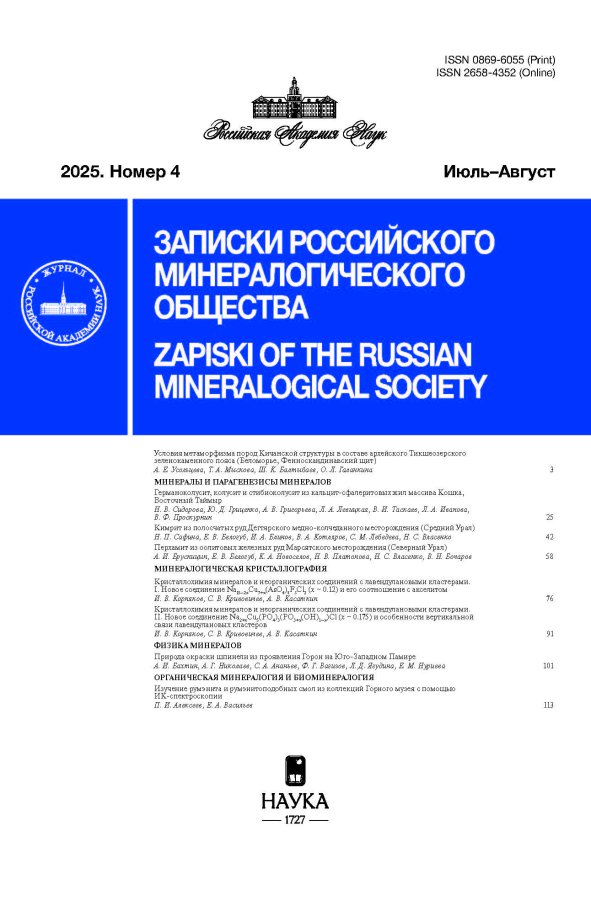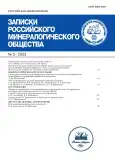Vol CLII, No 5 (2023)
Typification of Rare-Metal Alkaline Granites
Abstract
A new variant of classification of rare-metal alkaline granites is proposed with allocation of three types, essentially differing on chemical and mineral composition and features of their Rare Metal - Rare Earth specialization. The average composition of rocks from reference massifs of each type of rare-metal alkaline granites is given, the selected types are briefly characterized and their most important indicative features are emphasized.
 1-13
1-13


Basalt Alteration in High-Temperature Oxidizing-Type Fumaroles at the Tolbachik Volcano (Kamchatka, Russia). Part 2. Gas Metasomatites
Abstract
Five specific types of silicate apobasaltic gas metasomatites formed in the temperature range from 850–900 to 450–500 °C have been identified and characterized in oxidizing-type fumaroles at the Tolbachik volcano (Kamchatka, Russia): (1) diopside-esseneite, (2) haüyne-diopside, (3) anorthoclase/Na-sanidine, (4) sanidine, and (5) fluorophlogopite/sanidine-fluorophlogopite metasomatites. Exhalation incrustations of certain mineral and chemical composition are related to each of these types. In the vertical section of the fumarole system from bottom to top, against the background of volcanic gas cooling, a sequential spatial change of the first four types of gas metasomatites occurs. Fluorophlogopite and sanidine-fluorophlogopite gas metasomatites have not a clear position in the vertical section of the fumarole system and presumably are formed under the action of a gas significantly enriched with Cl and F. Highly siliceous metasomatites, consisting mainly of silica phases, form instead of silicate rocks at temperatures below 450–500 °C.
 14-65
14-65


МИНЕРАЛОГИЧЕСКАЯ КРИСТАЛЛОГРАФИЯ
Structural Transformations of Minerals in the Earth’s Mantle: the New High Pressure Polymorphous Modifications of Olivine and Wollastonite
Abstract
There are reviewed important results obtained in the studies of HP-minerals during 2018–2022 years. The emphasis is made on the characterization of HP-polymorphs modifications of olivine (asimovite, poirierite) and wollastonite (breyite and davemaoite) discovered in this period. The structure of poirierite (ε-Mg2SiO4) contains the unique silicate chain Si3O9 with one tetrahedron in its period. Consequently its structural formula is Mg2[SiO3]O, and its intergrowth with wadsleyite/ringwoodite in shocked chondrites support the idea that transformations of olivine into ringwoodite becomes via forming of poirierite. The close ratio of cell parameters in wollastonite (1T) at 8.9 GPa and its synthetic analogue CaGeO3 exhibits the similarity of their structures. The HP/HT data confirm the stability of the wollastonite polymorph (1T, 2M, pseudowollastonite and synthetic analogue of breyite) at the upper mantle conditions. The crystal structures and composition of new НР-minerals discovered as inclusions in diamonds, in meteorites and in the rocks near terrestrial impact craters provide the richer information on the complicate petrology of deep-seated geospheres which cannot be obtained on the base of laboratory experiments.
 66-82
66-82


DFT Modeling of the Hydrogen Bonding System in Sampleite
Abstract
The article provides a crystal chemical description of the second find of the P21/n modification of NaCaCu5(PO4)4Cl∙5H2O sampleite found at the Kester tin ore deposit. The mineral formation is genetically related to low-temperature oxidation processes of primary copper, zinc, and tin sulfides as well as to the formation of later Cu-, Zn-phosphates such as batagayite, epifanovite and sergeysmirnovite. The positions of hydrogen atoms in the structure of sampleite have been calculated with the DFT-method. The comparison of the real and theoretical IR spectra was carried out as an assessment of the reliability of the theoretical calculations. Sampleite was formed at the stage of hydrothermal alteration of Sn, Cu and Zn sulfide minerals and co-exists with epifanovite NaCaCu5(PO4)4[AsO2(OH)2]∙7H2O, which is undoubtedly a later one, but has a lower complexity (IG,total), 474.24 than sampleite 933.32 (bit/cel).
 83-99
83-99


HISTORY OF THE SCIENCE
Minerals Named in Honor of Alumni and Staff Members of the Saint Petersburg State University (to the 300th Anniversary of Saint Petersburg State University)
Abstract
The article is dedicated to the 300th anniversary of the Saint Petersburg State University. History of the University is closely connected with the names of scientists who have made a huge contribution to the development of mineralogy, adjacent sciences and education. The names of 70 alumni and staff members of the University have forever entered the history of mineralogy. 85 mineral species are named in their honor. The article summarizes the scientific interests and achievements of professors and scientists, after whom the minerals were named.
 100-126
100-126


Rereading V.I. Vernadsky: on the 160th Anniversary of the Birth
Abstract
On the base of analysis of the bibliography and the main scientific works, there is traced the creative evolution of V.I.Vernadsky: from special issues of mineralogy and crystal chemistry to the creation of the basis of geochemistry and biogeochemistry, and further to the concept of the biosphere and the noosphere. Not only his scientific results have methodological importance but also the way of formation of his scientific outlook which absorbed the discoveries in physics and biology in the end of XIX–first half of XX centuries. The article is timed to the 160th anniversary of his birth.
 127-138
127-138


ДИСКУССИИ, КРИТИКА, БИБЛИОГРАФИЯ
Contamination in Mineralogy: Pathways and Effects
Abstract
Contamination is considered as the ingress of material into an object that is not characteristic of this object. From this point of view, technogenic contamination, associated with human activity, and natural contamination, not depending on humans, are distinguished. The study of contamination is relevant in relation to the research process: neglect or misunderstanding of this phenomenon can lead and often lead to erroneous conclusions, forecasts, and estimates regarding the objects of study. Contamination does not necessarily have a negative meaning, and both types of contamination can be useful. Both types of contamination are considered on specific examples.
 139-146
139-146












